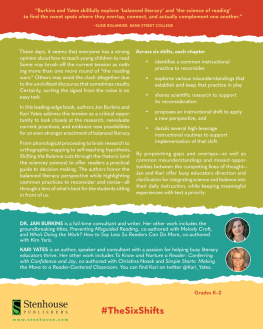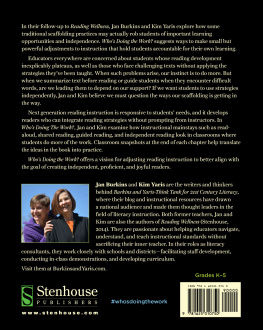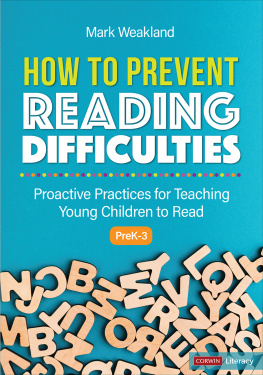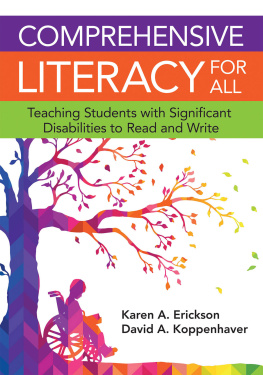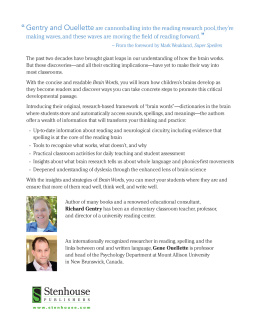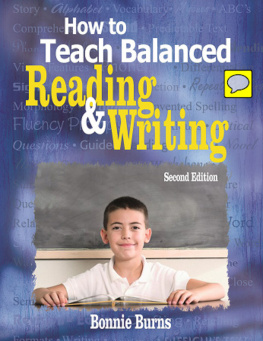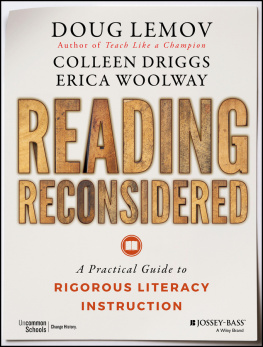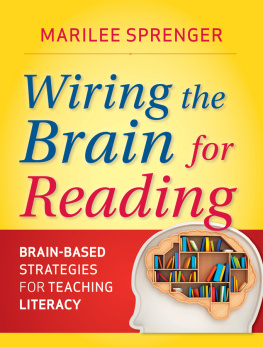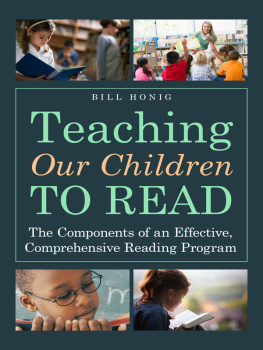.

What are the research-based, critical elements for teaching reading? In Shifting the Balance, Jan and Kari give you the information, classroom examples, and tools to help you make the best decisions around six key shifts for instruction. After reviewing the misunderstandings, the science, and the needs of your students, you will be able to audit your current practices (individually, in a PLC, or system-wide) to provide responsive and effective literacy learning for all your students.
Fran McVeigh, Teacher, Consultant, #G2Great Chat Moderator and Associate Academic Coordinator for Morningside College

In Shifting the Balance, Jan and Kari invite us to reflect and reexamine our beliefs about teaching reading. They gently nudge us to rethink and possibly adjust our early literacy practices. Jan and Kari have taken on this controversial topic by embracing vulnerability and modeling what it means to be truly reflective practitioners. This book is a must read for new and veteran teachers!
Jennifer Allen, Literacy Specialist, Waterville Public Schools, ME

Shifting the Balance is a welcoming opportunity to reexamine our familiar teaching practices. Without judgment, Burkins and Yates invigorate these practices by inviting educators to make scientific shifts in the systems that have been in place for years. This book will revolutionize reading instruction and in turn, the lives of countless students.
Jennifer Clyne Stewart, M.Ed., Dyslexia Specialist

This book speaks to teachers. It is overwhelmingly clear that Jan Burkins and Kari Yates have been and are immersed in the world of todays classrooms. Shifting the Balance will help many rethink instruction in ways that will support all students. In the current version of the Reading Wars, it is difficult for any of us to say we were wrong about some of our beliefs or practices. And thus, few do. However, Jan Burkins and Kari Yates have done just that. This is as commendable as it is unusual.
David Liben, www.readingdoneright.org

Science of Reading, Balanced Literacy, Reading Warswhat is a school to do? Who do we listen to? The six shifts introduced in Shifting the Balance became our launching point for our campus, resulting in a solid foundation for our reading instruction that allows us to develop joyful, strong readers who love books, love to read, and are equipped to successfully navigate the print and make meaning while doing so. Dont just read this book: debate, discuss, and learn from Jan and Karis ideas and impact your children just like we are!
Kristy Thomas, Principal of Rock Rest Elementary

Finally, a book that has the power to stop the literacy pendulum swings! In Shifting the Balance, Burkins and Yates skillfully explore balanced literacy and the science of reading to find the sweet spots where they overlap, connect, and actually complement one another. The result is a resource that raises our level of instruction while helping children discover and reap the joyful rewards of reading.
Susie Rolander, Bank Street College

This book found me at just the right time! Shifting the Balance gives voice to the questions Ive had in my mind about Balanced Literacy and the Science of Reading and provides clear insights on how to connect the best parts of both to benefit early readers. Throughout the book, Jan and Kari confirm practices worth holding onto while providing actionable next steps I cant wait to implement with students to strengthen my reading instruction.
Kristen Mullikin, Reading Specialist, Elk Grove Unified School District

In Shifting the Balance, Kari and Jan have masterfully dispelled many of the myths and misunderstandings associated with reading instruction. Additionally, they offer classroom teachers and coaches six simple, practical shifts that have the power to transform the way we teach children how to read. Indeed, balanced literacy and science do exist in harmony, and we practitioners can offer our children both concurrently. Thank you, Kari and Jan, for this important work that is sure to change lives!
Christina Nosek, co-author of To Know and Nurture a Reader: Conferring with Confidence and Joy

In Shifting the Balance, Jan Burkins and Kari Yates provide a safe space for teachers to courageously examine some long-held balanced literacy practices and turn a critical eye to where those practices have gotten out of balance. If youre willing to be vulnerable and move towards resolving the gap between research and practice, this book provides actionable steps you can take to shift your thinking and bring instruction into alignment with the scientific evidence.
Helen White, Instructional Support Teacher, Northside Independent School District

Burkins and Yates are intent on building a bridge in Shifting the Balance by finding compelling opportunities in K2 classrooms to align research and instructional practice. One of the several issues they discuss is intentionally supporting oral language development in the classroom, a key aspect of literacy instruction that is missing or misunderstood regardless of approach. They find common ground and build a broader understanding that leads to a strong comprehensive literacy design.
Adria Klein, Professor Emeritus, CSU San Bernardino

www.stenhouse.com
Copyright 2021 by Jan Burkins and Kari Yates
All rights reserved. This e-book is intended for individual use only. You can print a copy for your own personal use and you can access this e-book on multiple personal devices (i.e. computer, e-reader, smartphone). You may not reproduce digital copies to share with others, post a digital copy on a server or a website, make photocopies for others, or transmit in any form by any other means, electronic or mechanical, without permission from the publisher.
Every effort has been made to contact copyright holders and students for permission to reproduce borrowed material. We regret any oversights that may have occurred and will be pleased to rectify them in subsequent reprints of the work.
Library of Congress Cataloging-in-Publication Data
Names: Burkins, Jan Miller, author. | Yates, Kari, author.
Title: Shifting the balance : 6 ways to bring the science of reading into the balanced literacy classroom / Jan Burkins and Kari Yates.
Description: Portsmouth, New Hampshire : Stenhouse Publishers, [2021] | Includes bibliographical references and index. |
Next page
